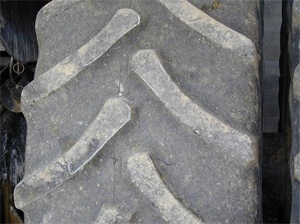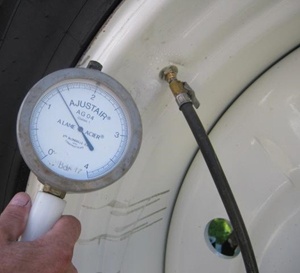There could be many different reasons for tyre wear, and before you replace your worn tyres it would be useful to get a good idea of the exact causes of this wear, especially if it's happening quicker than expected. This will stop you from having the same problem with your new set of tyres.

Below we'll go through the four main causes of agricultural tyre wear, some of which are linked to usage and others that are due to more complex issues.
Replacing your agricultural tyres can cost a lot of money, so before you commit you should identify the exact causes of wear to your current tyres.
The reason why your tyres have worn so quickly can probably be found somewhere in this short list. That said, sometimes there is more than one cause and it can be tricky to ascertain which is the main cause of wear.
If you notice that there is more wear on the front tyres than the rear, or if the wear is predominantly on only one side of the tyre and there is left/right symmetry, check the front differential, the wheel alignment, and the clearance in the steering ball joints and bearings.
When the tyres are already worn, they can be swapped over to increase their service life, making sure to resolve any mechanical issues beforehand and security first. Don’t use tyres which represent a risk.

Agricultural tyre wear due to road use
If your tyres are smooth with more noticeable wear on the central lugs, you almost certainly frequently drive on roads with too big a load. Tyre wear is accelerated by the road surface, which is harder and more abrasive than soft soil, and the higher driving speeds. Check the distances travelled with the vehicle, and the split between roads and fields.
If the wear is confined to the outer side of the right tyre and the inner side of the left tyre, this is called sloped wear and is most likely caused by an incline in the road you regularly drive on. This type of wear is worsened by the constant steering adjustments needed to keep the tractor in lane.
To maximise the service life of your tyres, don't drive faster than the recommended speed limit for your vehicle, as doing so will cause the rubber to overheat and weaken.
Furthermore, how the tyre rubber behaves depends on the amount of pressure it is put under (which is directly linked to the load) and the driving speed. It's the combination of these factors that directly impacts the amount of wear.

Adjustment of the pressure
of a tractor tyre
If a tyre is under-inflated, it "bounces" off the ground and results in abnormal wear to the shoulders and lugs (with wear to only one of the two). Rather than being absorbed, the strength of the vibration felt by the farmer may actually increase.
If tyre pressure is too low when driving on a road, the materials will heat up and the rubber components will separate from the nylon, rayon or metal elements, therefore resulting in tyre degradation.
On the other hand, over-inflation also increases wear to the tyre tread, this time to the tip of the lugs; the tyre bulges and the central part comes under a lot of stress, and therefore wears more quickly.
Heavy loads increase the amount of strain on the casing and tread, and can lead to permanent deformation that will in turn accelerate lug wear.
Therefore, if you are pulling a heavy load, reduce your speed when driving on roads to reduce strain on the tyre tread. By doing so, you will minimise heating and damage to the rubber.
Also check that your agricultural vehicle's load index is suited to the maximum loads being transported (see the load index table provided by the manufacturer), and make sure not to overload your tyres by reducing the load being transported if necessary. If the load index is too low for the work you're doing, the strength of the casing cannot be guaranteed.
Tyre wear is inevitable. It's essentially caused by the rubber rubbing against the soil or road surface, and should usually be uniform across the entire width of the tyre tread.
To learn more and boost your farm's profits, Bridgestone Agriculture is offering you a free, detailed eBook that explains the essential role your agricultural tyres play in your productivity.
The most people who have read this article have also read the following articles, which are listed below in order of popularity:
This information is intended only to make you aware of the technical and functional aspects of agricultural tires and their use. It does not allow you to make a judgment or a definitive conclusion on a given problem. Only your agricultural tire expert is able to make a technical assessment and take a final decision, case by case.

BRIDGESTONE EUROPE NV/SA
AG Department
Leonardo Da Vincilaan 1
1930 Zaventem | Belgium
Our regional office:
Athena Drive, Tachbrook Park
Warwick CV34 6UX
United Kingdom